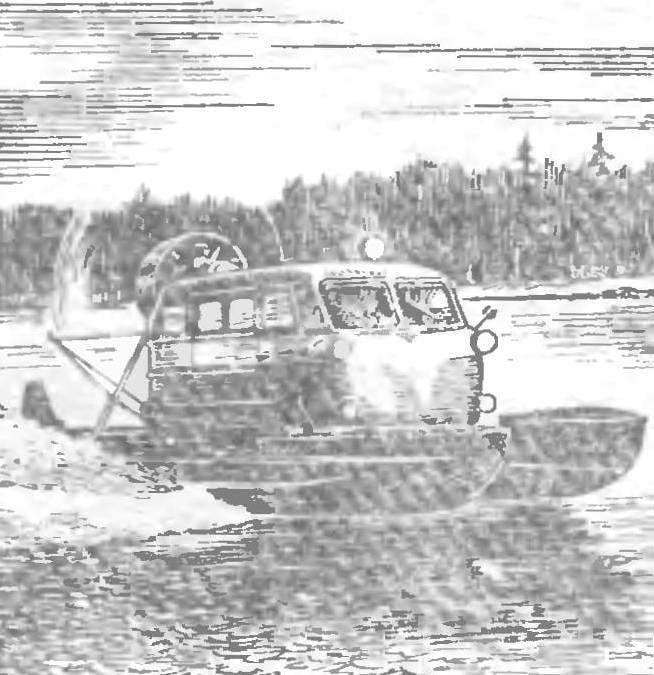The magnitude of the force T depends on the angle of attack and the speed at which the plate moves in the flow.
If we consider the balance of forces T and X, depending on the angle of attack at a constant rate, it would appear that the resistance increases gradually and reaches maximum at vertical position of the plate. The force of the thrust first increases (up to about the speed of the angle of attack), and then decreases sharply. Therefore, for each speed there can be only one best angle of attack.
Fig. 1. The forces acting on the direct plate and airfoil when moving in the air stream:
V free — stream velocity, X is the force of air resistance, and angle of attack, the P1 — force P2 is the force of vacuum, R is the resultant, T — traction force, the lifting force of the nln, I,2 — the length of the upper part of the profile, I1 is the length of the bottom.
Fig. 2. Types of propellers:
A — wooden block B — block metal In the screw with the installation of the blades in place with the safety nut d — screw with a split nut and pinch clamps.
1 — sleeve, 2 — blade, 3 — nut, 4 — pinch clamp, 5 — bolt with nut.
Fig. 3. The scheme of air variable-pitch propeller with mechanical control:
1 — intermediate rocker, 2 — axis, 3 — sliding clutch 4 — control rod 5 — arm vanes, 6 — nut of fastening of the bushing 7 bushing screw, 8 — counterweight, 9 — blade, 10 — hinge thrust, 11 — drive shaft 12 — the control lever by changing the pitch of the screw in the driver’s cab, 13 — detent control lever 14 is notched, 15 — pull.
And move the clutch B — lift levers the blade, To move the intermediate rocking, G — pen in position, small step, D — pen in position stride, E — stick in the reverse position.
If the plate is not flat, but is made in the form of an airfoil (see Fig. 1B), depending on its shape, the magnitude of the lifting force under other equal conditions increases significantly. Airfoil is more beneficial than a straight plate. Flow rate the upper and lower contours are different, and therefore, ambiguous and pressure. Therefore, such a profile, even at zero angle of attack creates lift. At the same time, its resistance is less than that of the straight plate like this I thickness.
An important parameter determining the purpose of the propeller is the size of step (N). Step is determined by the angle of attack of the cross section of the blade located at 0.75 of the radius of the screw. Expressed N the distance which passes a screw for one complete revolution. Screw figuratively can be compared to a nut screwed on the bolt. The distance that the nut goes on the thread for one full turn is a step. It is determined by the formula:
N = 1,5 ПR tgα,
where: R — radius of rotor, α is angle of attack (installation) profile.
But the bolt and nut solids. Of air screw rotates in a compressible medium having a low density. However, he slips moving forward on a much smaller distance than the calculated step.
The greater the load on the screw, the more the amount of slip and more than the actual pitch. The actual step determines the load on the drive motor and affects the economy.
The use of variable-pitch propellers allows to obtain the highest coefficient of performance (COP), and hence the greatest thrust. However, only one corresponding to this step, the estimated mode. Designers snowmobiles often made air block screws, made of solid or glued wooden beams (Fig. 2). Such a screw can be made of metal.
In practice, depending on road conditions it is desirable to vary the step size. When moving from place, it is necessary to obtain maximum thrust (pitch should be small), and with increasing speed step should be increased.
The picture shows the screws in increments, adjustable on site. These screws are widely used on a homemade sled. They can be two-, three – and four-bladed. The hub and blades are made separately. Sleeve made of steel or duralumin is provided with a bore cone with keyway for mounting on the motor drive shaft and has a socket under the blades. Socket can be threaded (Fig. 2C), or with annular grooves machined, if the sleeve is detachable (Fig. 2 G). The number of slots corresponds to the number of blades. The blades are made from wood, plastic with a reinforced butt part or made of metal. If they are mounted on the threads, the inboard end part of the threaded shank.
For a more accurate setting of the blades to the desired angle of attack on their shanks applied to control risks, and on the end portion of each socket in the hub on the graduate scale protractor angles to the screw range, e.g. from 3°-5° to 25°-30°. When assembling all the blades are set at the same angle and counter nuts.
 Many readers, building a snowmobile and a boat with propellers, in his letters to the editor are asked to tell how the variable-pitch propellers and what advantages they possess. In response to that request, the published material prepared by the consultant of the public KB, “M-K” on snowmobiles I. N. By juvenalian.
Many readers, building a snowmobile and a boat with propellers, in his letters to the editor are asked to tell how the variable-pitch propellers and what advantages they possess. In response to that request, the published material prepared by the consultant of the public KB, “M-K” on snowmobiles I. N. By juvenalian.
